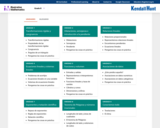
Per April
- Subject:
- Mathematics
- Material Type:
- Activity/Lab
- Assessment
- Full Course
- Homework/Assignment
- Textbook
- Author:
- Illustrative Mathematics and Kendall Hunt
- Date Added:
- 09/17/2020

Per April
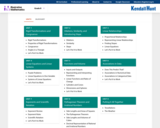
Per April
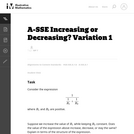
Students are asked to consider the expression that arises in physics as the combined resistance of two resistors in parallel. However, the context is not explicitly considered here. The task is good general preparation for problems more specifically aligned to either A-SSE.1 or A-SSE.2.
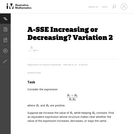
The purpose of this task is to help students see manipulation of expressions as an activity undertaken for a purpose.
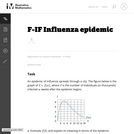
The purpose of this task is to probe students' ability to correlate symbolic statements about a function using function notation with a graph of the function, and to interpret their answers in terms of the quantities between which the function describes a relationship
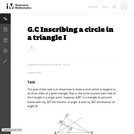
This task shows how to inscribe a circle in a triangle using angle bisectors. A companion task, ``Inscribing a circle in a triangle II'' stresses the auxiliary remarkable fact that comes out of this task, namely that the three angle bisectors of triangle ABC all meet in the point O.

This task is primarily for instructive purposes but can be used for assessment as well. Parts (a) and (b) are good applications of geometric constructions using a compass and could be used for assessment purposes but the process is a bit long since there are six triangles which need to be constructed.

This task provides an opportunity for students to apply triangle congruence theorems in an explicit, interesting context.
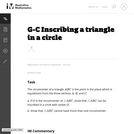
This problem introduces the circumcenter of a triangle and shows how it can be used to inscribe the triangle in a circle. It also shows that there cannot be more than one circumcenter.
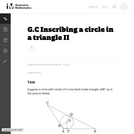
This task focuses on a remarkable fact which comes out of the construction of the inscribed circle in a triangle: the angle bisectors of the three angles of triangle ABC all meet in a point.
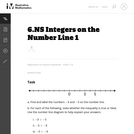
In this task students are asked to label negative numbers on a numberline and then answer questions about which are greater or less than.
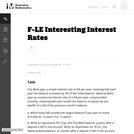
This real world task requires students to compare differing interest rates.
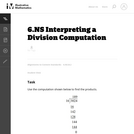
This division task asks studnets to consider the conceptual understanding of something usually taught as a rote procedure. To be successful with this task, students must make sense of the procedure and how place value is represented and abbreviated within it.
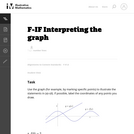
The purpose of this task is to help students learn to read information about a function from its graph, by asking them to show the part of the graph that exhibits a certain property of the function. The task could be used to further instruction on understanding functions, or as an assessment tool with the caveat that it requires some amount of creativity to decide how to best illustrate some of the statements.
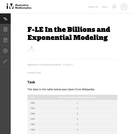
This problem provides an opportunity to experiment with modeling real data. Populations are often modeled with exponential functions and in this particular case we see that, over the last 200 years, the rate of population growth accelerated rapidly, reaching a peak a little after the middle of the 20th century and now it is slowing down.
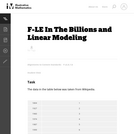
This task rquires students to determine if linear functions would be useful to model relationships presented in a data table.
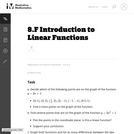
This task lets students explore the differences between linear and non-linear functions. By contrasting the two, it reinforces properties of linear functions. The task lends itself to an extended discussion comparing the differences that students have found and relating them back to the equation and the graph of the two functions.

When students plot irrational numbers on the number line, it helps reinforce the idea that they fit into a number system that includes the more familiar integer and rational numbers.
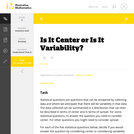
This is a task from the Illustrative Mathematics website that is one part of a complete illustration of the standard to which it is aligned. Each task has at least one solution and some commentary that addresses important aspects of the task and its potential use.
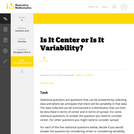
This is a task from the Illustrative Mathematics website that is one part of a complete illustration of the standard to which it is aligned. Each task has at least one solution and some commentary that addresses important aspects of the task and its potential use.